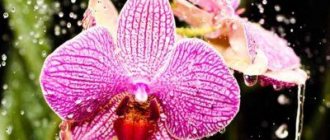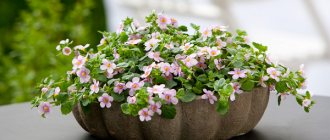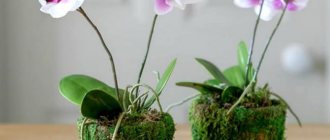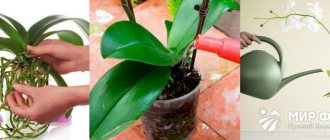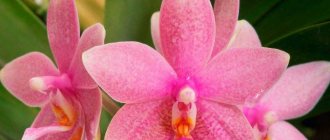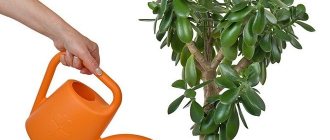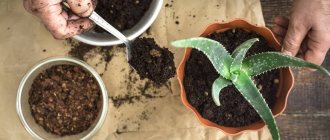Basic rules of watering
Water the flower when the substrate in the pot begins to dry out. The intensity of watering will depend on many nuances: room temperature, humidity, sunlight, period of life, and much more.
Since in its natural environment the orchid is nourished by rain, it is advisable for flower growers to use water whose composition will be close to that of rain. The water should be at room temperature, and in no case hard . Tap water almost always needs to be softened. For these purposes, you can use special oxalic acid, which is sold in every flower shop and is used to soften water. A day before the intended watering, you need to make a solution (for 5 liters of water you will need 1/8 tsp of oxalic acid). Immediately before irrigation, the water is drained from the sediment and then filtered.
Tropical flowers are watered in the morning so that during the day the water evaporates from the axils of the leaves. Water for irrigation must be saturated with oxygen. To do this, immediately before watering, it should be poured several times from one container to another.
Water for irrigation
The best liquid for watering orchids is soft water with a neutral pH value. Tap water often does not meet these requirements and therefore needs to be disinfected and softened.
Experienced gardeners recommend treating water in one of the following ways:
- boil or filter - this will help get rid of chlorine compounds, bacteria and other dangerous impurities;
- dissolve 1/8 teaspoon of oxalic acid in 5 liters of water and let the solution sit for 2-3 days, then carefully pour the liquid into another container without shaking the precipitate;
- add 1 clove of garlic per liter of water to disinfect the plant and activate the flowering process;
- prepare a weak solution of permanganic acid as a root disinfectant.
The use of distilled water should be avoided. This product is only suitable for washing roots and leaves.
The water temperature for watering orchids should not be below room temperature. The most comfortable option for flowers is from 25˚ to 35˚ Celsius.
How often can you water orchids?
How often to water an orchid at home? There is no specific answer to this question. The frequency of watering depends on the temperature and humidity in the room where the orchid grows, on the type of substrate in the pot, as well as on the time of year. During the rest period after flowering, the plant does not require frequent watering; this fact should also be taken into account when choosing the frequency of watering. An orchid will feel good if you create conditions similar to those in which it grows in the wild.
How to determine what frequency of watering to choose. Florists recommend the following techniques:
- Watering orchids should be postponed if you notice droplets of condensation on the walls of the flower pot.
- Since the root system of orchids is on the surface, the condition of the roots can determine whether the plant needs watering. The bright green roots indicate that the flower does not need to be watered. If the roots become light, watering is required.
- You can lift a flower pot and determine by its weight whether the orchid needs water. A heavy flower pot indicates that watering is not needed yet. If the pot becomes light, be sure to water the orchid.
- Flower growers check the substrate with their fingers. If it is dry, the plant is watered.
- You can check the moisture content of the substrate with a toothpick, similar to a cake in the oven. Any housewife knows how to check the readiness of the pie: poke holes with a toothpick, after which the toothpick is removed. If it is dry, the pie is ready; if there are pieces of dough stuck to it, the pie is left to finish baking. Pierce the substrate with a toothpick. If particles of the substrate stick to the wooden stick, it is too early to water the flower.
- If you notice that the soil in which the orchid grows has become lighter, this means that the flower needs watering.
The frequency of watering also depends on the type of flower. When purchasing an orchid, ask what kind of watering is needed for this type of plant. As a rule, orchids are watered 1-3 times a week in the summer, and only a few times a month in the winter.
How should this be done correctly?
There are several options for watering orchids, each of which is effective in its own way . The method should be chosen based on the time of year, living conditions and air humidity. If there are several specimens in the collection, then they should be divided into groups with separate watering. Plants can be changed periodically to determine the most productive watering method.
An orchid is a tropical plant that is not accustomed to frost and cold. The temperature of tropical rains does not fall below +15 degrees. Watering with ice water will instantly destroy the root system.
What kind of water is suitable
Much depends on what kind of water is used to water tropical flowers. In the wild, orchids are watered by rain, but in our ecology, rainwater can contain a whole range of different chemical components, so it is better not to use it for watering.
The water you use to water the plants should be soft. There are many ways to determine the degree of water hardness. One of the indicators that hard water is flowing from the tap is that scale forms in the kettle very quickly.
You can buy special tests to determine the degree of water hardness, which will accurately determine how hard your tap water is. Before watering flowers, hard water should be softened.
Water softening methods
- Oxalic acid, which is diluted in water and left for a day. After this, the water must be carefully drained, being careful not to touch the sediment.
- A canvas bag filled with high-moor peat is left in the water for irrigation. Before watering, the bag is removed from the container. This method will not only soften, but also acidify the water.
- Before watering, the water is passed through a household purification filter several times.
- Quite often, experienced flower growers use boiled water at room temperature to water their flowers. When boiling, all harmful microbes are killed, chlorine is eliminated, and heavy salts precipitate.
- To improve the condition of the water used for irrigation, many add garlic, succinic acid, and potassium permanganate. Garlic water helps improve the flowering of orchids, and at the same time disinfects the plant. Amber water increases the plant’s immunity, helping the orchid to better resist various diseases. A weak solution of potassium permanganate helps disinfect the roots.
Novice gardeners make the mistake of using distilled water for watering. It is strictly forbidden to water an orchid with purified water! Distilled water is used for washing leaves, roots, irrigation, and also for diluting fertilizers.
The water temperature for irrigation should vary between 30-40 degrees. It is also important what acidity the water will have. The ideal pH level is 5.5. Check acidity using litmus paper. If the acidity level of the water is lower, add a few drops of freshly squeezed lemon juice.
Water quality
To water orchids, you can use regular tap water. You should first settle it in order to eliminate harmful impurities, heavy salts, which not only do not bring any benefit, but can also damage the flower. Only soft water is allowed. If your water supply comes from hard water, you should not use it.
Only soft water is suitable for orchids
On a note! It is allowed to use not only tap water, but also settled rainwater and distilled water. It is advisable to boil the liquid in advance or purify it by passing it through a filter.
Rainwater
If you decide to store rainwater to water your orchids, you must adhere to these rules.
- Collect liquid outside the city limits so that the plantings are not negatively affected by dust, which is found in large quantities in urban environments.
- After collecting rainwater, store it in a cool place. This way you can reduce the rate of bacterial growth.
Rainwater harvesting
Rainwater is most suitable for watering orchids. It is not always possible to use it, since in the city rainwater can do more harm than good. To avoid damaging the flower, it is necessary to store water in proper conditions.
Boiled water
If you notice increased water hardness, you need to boil it. This will make the liquid softer. There are no harmful effects of boiled water on plants.
Hard water needs to be boiled
Test strips for determining water hardness
Distilled water
If you decide to water your orchids with distilled water, you need to dilute it with tap water, focusing on the level of hardness. If the water is very hard, you need to dilute it with tap water in a ratio of 1:2. If the liquid is of medium hardness, it is enough to mix it in a 1:1 ratio.
When using distilled water, you can independently determine the desired level of salt content and adjust it by changing the proportions. Among the disadvantages of watering with distilled water is the high cost. The money spent is especially noticeable if the grower breeds orchids in large quantities.
Distilled water
Filtered liquid
If you use special filters to purify running water, you can quickly remove heavy metals and dangerous bacteria from the water. Purified water is more suitable for irrigation than regular tap water. In most cases, a large amount of money is not spent on water purification. Among the disadvantages of watering with filtered water is the low cleaning speed, especially when caring for a large number of orchids.
Compact device for water purification in an apartment
To speed up the growth and development of an orchid, it is advisable to pay attention to the acidity of the water. The optimal indicator is pH5. To determine the acidity level, you need to use litmus paper. Moisture enriched with oxygen is beneficial for an orchid. To enrich water, just pour it from one container to another.
Litmus paper for pH determination
This is a pH meter - a device for determining the acidity (pH) of water
Video - Watering an orchid
Watering methods
Depending on what kind of orchid you have, watering can be of several types:
Hot shower
Watering as close to tropical rain as possible will help the orchid stay healthy, grow faster, and bloom more often. Constant showering is a preventive measure against pests and bacteria. How to give an orchid a shower:
- The orchid pot should be placed in the bath. Using a shower head, turn the pressure to low and spray the plant with warm water. The water temperature should be about 45 degrees.
- As soon as the substrate is completely saturated with water, the orchid should be left in the bathroom for 20-30 minutes so that all excess moisture drains away.
- After this, using a soft, dry napkin or cloth, carefully wipe each leaf and young sprout. If you shower a Vanda or Phalaenopsis orchid, you should wipe the core dry, otherwise the plant may begin to rot.
- Take the pot out of the bathroom and place it in its usual place - if it is a windowsill, you should make sure that the orchid does not get direct sunlight.
Immersion of the plant
A fairly popular and effective method of watering, but it is used only when the orchid is completely healthy. The pot along with the orchid is lowered into pre-prepared water. Pots measuring about 12x12 cm are left in water for half a minute, after which they are kept in the air so that all excess water has time to drain.
Classic watering
Many gardeners are accustomed to watering indoor plants with a special watering can. Orchids can also be watered using a watering can, using very low pressure. Water flows until excess moisture begins to drip from the holes below. Wait until the unnecessary water pours out of the pot, then repeat the procedure. Make sure that the water remaining in the pan is poured out in a timely manner, otherwise the plant may rot.
Irrigation of the root system
In the case when an orchid is grown without a substrate, irrigating the roots is the best method of watering. In a pot with a substrate, the roots do not dry out as much as when growing orchids using blocks. You will need a special flower spray. Set the “Fog” mode and point the spray bottle directly at the roots. Irrigate until the color of the roots begins to change from earthy to green. A repeat procedure will be needed when the roots begin to dry out.
Surface watering
This method uses a watering can, from which the substrate itself is watered with a thin pressure. The water slowly fills the substrate and then evaporates over several days. You need to water until the substrate is completely wet with water. Under no circumstances should you overwater an orchid! Surface watering is considered the most affordable and simple method.
Watering in a tray
Those flower growers who value their time use the method of watering flowers using a tray. The process is very simple and quick: pots with orchids are placed on one large tray, into which you need to pour pre-prepared water. Orchids themselves will take as much water as they need.
Watering at home
The frequency of watering directly depends on the plant variety, as well as the conditions under which it is kept. Conditions under which watering differs:
- soil composition;
- temperature regime (time of year);
- Times of Day;
- light level;
- physiological state of the flower (rest or active growth).
Florists need to take these factors into account, since temperature changes are always accompanied by changes in humidity levels.
Sprinkling (shower)
This method is quite often used when watering orchids. This is due to its similarity to the effect created by tropical rains. Its use promotes leaf growth, which has a beneficial effect on flowering. Equally useful is regular washing of the leaves: this prevents the appearance of pests.
This watering method is as follows:
- Transfer the plant to the bathroom and gently water it with a weak stream of water using a shower head. The water temperature should be +40…+52 degrees. The duration of watering is not determined, since it depends on the time the water is absorbed by the soil.
- Excess liquid from the soil should drain. To do this, leave the flower in the bath for a while.
- Remove excess liquid from the axils and leaves with a soft cloth. Neglecting this recommendation leads to rotting of the core and, as a result, lack of growth.
Attention! This watering method is recommended for use only by apartment owners. This is due to the hardness of the water: it is soft in water pipes.
Dive
This watering method is as follows:
- Immerse the flower pot in water so that the water covers the entire soil.
- Remove it from the water and allow excess liquid to drain. If the plant was in water for 20 seconds, the same time is required for the soil to dry out.
- Remove excess liquid from the axils and leaves with a napkin.
When using this method, it is important to avoid over-wetting the substrate. It can only be used for orchids that do not show signs of disease.
Watering with a watering can
To water in this way you will need a watering can:
- Water the entire area of the substrate in a thin stream so that water does not get into the axils of the leaves and onto the growing points of the flower.
- Stop watering when the water wets all the soil and begins to flow out of the holes in the pot.
- Excess liquid from the soil should drain, after which the procedure should be repeated one more time.
- Finally, remove excess liquid from the leaves and axils.
Interesting! This method of watering is recommended to be carried out before 12 noon.
Spraying
This watering method is good for plants that are grown using blocks rather than soil. This is due to the fact that their roots lose moisture very quickly, which means more frequent watering is needed.
Spraying features:
- the maximum effect is achieved only if the spray bottle is switched to light haze mode;
- use settled water for the procedure;
- so that the root system has time to dry, it is recommended to spray in the first half of the day.
Peculiarity! The structure of the water does not affect the number of sprays, however, when using distilled water, the plant will be deprived of essential nutrients and microelements. This will cause the flower to wither and die.
How to water orchids when they bloom
How to water orchids that are starting to bloom? As soon as the orchid enters a period of active flowering, the frequency of watering increases to several times a week . The ideal is to water 2-3 times every 7 days . Water the flower early in the morning, under no circumstances allowing the roots to flood. After the flower stalk appears, watering becomes more frequent as the plant needs additional nutrition.
If the orchid blooms in a dry room, it should be watered more often than usual. It is advisable to add irrigation to the leaves, but you should be very careful not to allow water to get on the flowers and buds themselves.
After flowering ends, when the flowers begin to fade, watering is halved. It is necessary to monitor the substrate: by the next watering it should be almost dry.
How to properly moisturize different types of flowers?
Dendrobium
Feature of the species: intolerance to excess moisture.
Before the next watering, the substrate must be completely dry!
Dependence of watering on the season:
- in summer, in the active phase of development: leaf growth, flowering - regular watering is required (once every 3-7 days);
- in winter, during the passive period , watering is practically eliminated.
Method: immersion.
Water: soft, settled or boiled. In the warm season - cool, in the cold - warmer than room temperature.
This video shows how to water a dendrobium orchid:
Lady's slipper
Feature of the species: the absence of thick leaves and pseudobulbs (part of the stem with a thickening), so it does not store water. The substrate must be kept moist at all times, and the roots must be regularly “nourished” with water.
Dependence on the time of year:
- Spring-summer - you can water up to 2 times a week.
- In winter – once a week is enough.
Method: any of those described above.
Water: settled, purified from salts.
This video explains how to properly water a lady's slipper orchid:
Cymbidium
Features of the species: during the growing season, the substrate must be constantly moist. There is an opinion that high humidity is natural for cymbidium, and it is difficult to flood it. But moderation is important.
- A sign of overwatering is the presence of black spots at the base of the leaves.
- A sign of overdrying is wrinkling of the pseudobulbs and wilting of the buds.
Dependence on the time of year:
- Late spring – summer period water after the soil surface has slightly dried.
- At the end of summer - beginning of autumn - up to 1 time every 10-12 days.
- In the autumn-winter period, watering is reduced to 1 time per week, provided the place is cool.
Method: immersion for 40 minutes or overhead watering (watering can) for 10-15 minutes.
Water: clean, soft.
This video explains how to water cymbidia in the summer:
Cumbria
Features of the species: even with recommended abundant watering, Cambria does not tolerate waterlogging. When caring for Cambria, you must follow a certain regime:
- during the entire period of pseudobulb growth - regular and abundant watering;
- from the moment the formation of pseudobulbs ends and until the flower shoot begins to grow, watering is reduced;
- during the flowering period - water regularly and plentifully;
- after flowering and before new growth appears, watering stops, this is the winter dormant period;
- Once the growth reaches 2-3 centimeters, watering is resumed.
Method: immersion. Spraying is not suitable - cambria is susceptible to fungal diseases. A hot shower as a hygienic procedure in the warm season.
Water: warm, boiled, purified.
This video shows how to water the Cambria orchid:
Wanda
Features of the species: repeated watering is required only after the substrate has completely dried, to prevent rotting of the roots.
Dependence on the time of year:
- spring-summer – every 3 days;
- winter – once a week is enough.
Method: preferably hot shower. Twice a month - immersion.
Water: clean, soft.
This video explains how to water a vanda orchid:
Watering orchids in winter
In the last months of autumn, the orchid rests in a dormant state. The flower no longer needs such frequent and abundant watering as in summer, during the flowering period. In winter, it is recommended to water orchids no more than once every two weeks .
In winter, the root system of orchids does not absorb water as actively, so the immersion method is considered the most suitable. After immersion, do not forget to allow excess water to drain completely so that the root system does not rot.
It is best to water flowers in the evening in the autumn-winter period. It is better to water in a warm bath, leaving the orchid in it to allow excess water to drain completely. You should not immediately place the flower in a cool room after watering. Sudden changes in temperature do not have the best effect on the condition of orchids.
Mistakes when watering
- Overwatering is the most common and at the same time very dangerous mistake, since the root system of orchids does not tolerate excess moisture very well, causing rotting of the shoots and death of the plant. As protection, you can use additional drainage, the thickness of which is at least 4 cm; the most recommended material is polystyrene foam.
- Moisture getting into the leaf sinuses. This usually happens when watering is carried out inaccurately, but in any case the plant cannot be left in this state; the water that gets into the sinuses must be removed out, which will avoid rotting.
- Spraying is carried out from a close distance, since this indicator should be at least 20 cm. Failure to comply with these measures leads to longer evaporation of moisture, drops remain on the surface of the plant longer, which leads to a general deterioration of its condition.
- Using water of unsuitable quality for irrigation. It is necessary to take a closer look at the condition of the plant; if it turns yellow and withers, then it may be necessary to conduct a water analysis to determine the cause of the disease.
How to water immediately after purchase
As you know, replanting orchids immediately after purchase is not recommended. After a change of environment, the plant experiences shock and must be given time to recover so that it gets used to the new place. Typically this will take about two weeks. After transplantation, the orchid immediately needs watering. Experienced flower growers, after the first transplant, place the flower pot in a large container with warm water, and after 20-25 minutes, take the pot out to drain excess liquid. After this, the orchid is placed in a place where it will not receive direct sunlight.
There is no need to water the orchid for two weeks after this. Subsequently, the plant is watered according to the standard scheme, at least several times a week. As a rule, by this time the orchid begins to bloom, and then watering is carried out according to the usual rules.
Hydrogen peroxide as a spray
You can use peroxide at a concentration of 3%. To increase the useful consumption of the drug, use microsprays in 50 ml bottles with a sprayer. This device will produce a small stream.
Note! All vegetative parts of the plant should be sprayed: foliage, stem, roots. Treat the visible part of the substrate. It is first important to make sure that there is no dust on the plant.
Carry out the procedure in non-sunny weather or in the morning and evening to avoid burns. The air temperature should be within 22 degrees. During processing, it is important to try to prevent drops from flowing down the stem and avoid getting on the flowers. After spraying, inspect the plant for the presence of water in the leaf axils and core. Remove excess liquid with a paper napkin.
The most important thing you need to know to successfully grow orchids is that their roots are different from the roots of, for example, a cactus, and therefore require a completely different approach to watering.
succinic acid
This is a fertilizer used only to help or restore the plant in the following cases:
- lack of flower growth;
- processing of phalaenopsis;
- the presence of signs of oppression (peduncles or a limp plant do not appear);
- resuscitation of dying flowers.
Note! In conclusion, we can say that the orchid does not need to be moisturized often. It is recommended to carefully monitor the plant’s reaction to the action of fertilizing. The frequency of treatment with succinic acid is up to twice a week for recovery and once a month for prevention.
After transplant
Orchids are replanted not only after purchase, but also after hibernation. It is worth noting that it is better not to use large pots. The more compact the flower pot into which the orchid is transplanted, the better the roots will develop in it. As soon as the flower is transplanted into a new pot with a new substrate, it should be watered immediately. Then the flower pot with the orchid should be placed in a container filled with warm water for 20-25 minutes. After this time, the excess liquid should drain, and then the pot is placed in a darkened room, away from bright sunlight. The next two weeks after transplantation, the orchid does not need watering. The flower experiences stress after transplantation, so it is better not to disturb it. Frequent watering can only worsen the situation, so you should leave the orchid alone for 14 days.
After the orchid adapts to new conditions, it will need additional nutrition, a comfortable place, and good care. You need to water the flower at least twice a week, ideally 2-3 times every 7 days. Orchids are replanted in the summer, before flowering begins, so watering should be more frequent.
Care depending on the time of year
In the autumn-winter period, orchids do not go into rest, but growth slows down. In winter, the plant is watered once every 10-14 days . Stagnation of water in the pan is unacceptable. Low temperature, insufficient lighting and a swamp in the pot will lead to rotting of the flower.
With the arrival of spring, watering the orchid increases to once a week with the addition of mineral fertilizers (find out how to feed the plant here). It is necessary to water the plant in the summer as the top layer of the substrate dries out. In summer, daily spraying with warm water is added to watering. The leaves of the plant must be wiped with a damp cloth. Their smooth surface is not able to independently repel dust and dirt that settles on them.
Sphagnum moss is great for retaining moisture in an orchid pot . It can be purchased dry in a store or dug up in the forest. It is recommended to place fresh moss in the freezer for a couple of weeks. This procedure will disinfect it.
What errors may occur
Improper watering can lead to disastrous results, including the death of the plant. What mistakes are made when watering:
- Excess moisture can cause root rot. To avoid this, it is necessary to install foam drainage approximately 4 cm high.
- When watering, water should never get into the axils of the leaves. If this happens, immediately wipe the leaves dry with a soft, clean cloth or napkin.
- Using the spraying method, this should be done at a distance of about 20 cm. Otherwise, large drops will form on the leaves and flowers, which negatively affect the appearance and condition of the plant.
- Water for irrigation must meet all standards. By using hard, too cold or contaminated water, you risk the health and even the life of your orchids.
- Prepare water for irrigation thoroughly in advance. It should be soft, comfortable temperature, with a suitable ph balance.
- It is necessary to water flowers only in the morning, since watering in the sun can cause burns. The optimal time for watering is early morning.
- The immersion method is used only when the orchid and the substrate are not infected with any diseases. Just in case, it is better to change the water after each pot. If the flower is in the incubation period, you will reduce the risk of infecting other orchids.
Procedure if the plant is flooded or overdried
During different life cycles, an orchid requires a certain watering regime. During the flowering period, a break of up to two weeks should be organized. If the frequency is disturbed, the plant will begin to rot from excess water. If a flower is flooded, it can only be helped if it is transplanted into a new substrate.
Important! If the roots begin to rot, it means that there are already harmful microorganisms in the soil, so it needs to be replaced.
The transplantation process should be carried out as follows:
- The roots of the plant are very fragile, so you need to carefully remove the flower from the pot. It is recommended to cut the pot to avoid damage.
- Before planting, the plant is washed with warm running water.
- Using scissors, rotting parts are removed and yellow leaves are removed.
- Sections must be treated with activated carbon to disinfect.
- The new pot is pre-washed using laundry soap. This is necessary for disinfection.
- A 5 cm thick expanded clay drainage is laid out at the bottom of the pot. A substrate is poured on top and the roots of the flower are placed on it. They are then covered with moist soil.
After transplanting the plant into a moist substrate, you do not need to water it immediately.
Orchid transplant
An incorrect watering regime can also lead to an acute lack of moisture. The first sign will be a change in the color of the roots. They will become lighter. To prevent drying out, you need to water the plant 2-3 times a week in hot weather, and reduce the procedure to 1 time in winter. In normal conditions, the soil should always be moist.
When a plant begins to dry out, the condition of its foliage and shoots changes. They lose their color, become wrinkled, the edges dry out, and a yellow stripe appears. Later they become brittle and crumble as soon as you touch them.
Most often, the dried plant can be saved. To do this, it is recommended that you first do the following:
- take a good look at the flower to make sure it has living roots;
- Moisten the soil regularly.
Plants come to life well if you provide them with bottom watering. To do this, water is poured into a saucer, then a pot with a flower is placed in it.
Important! If many roots are damaged, they will not be able to fully absorb moisture.
If the orchid does not have living roots, it can be restored by building a greenhouse. To do this, you will need a 5 liter plastic bottle, which is cut in half. Drainage is laid at the bottom, and a layer of sphagnum moss is placed on top. Then the affected plant is placed there. The top of the flower is covered with the second part of the bottle. It is important to maintain a high level of moisture inside. As soon as the plant forms new roots, it can be transplanted into soil with bark.
Watering is the most important factor for long-term flowering and health of an orchid. Knowing how to carry out the procedure correctly, you can extend the life of your favorite flower.
How to water a dwarf orchid
Dwarf orchids have recently gained active popularity. A small plant with beautiful flowers attracts many gardeners, but dwarf orchids require proper care. The health of the mini-orchid and its flowering depend on how correct the watering is.
How to water an orchid correctly? During the dormant period after flowering (this period occurs in the winter months), the mini-orchid should be watered no more than once every two weeks. In the warm season, when active flowering of all orchids begins, dwarf flowers should be watered once every 3-4 days.
The substrate or moss in the pot does not need to be moistened until the moisture has completely evaporated from it. Mini-orchids, thanks to their dry roots, receive the necessary oxygen, so under no circumstances should they be overfilled with water. The small phalaenopsis orchid loves to be watered by immersion in water. The pot with the mini-orchid is immersed in warm water and kept there for about 20-25 minutes. Dwarf orchids should not be left in water for a long time, otherwise rotting may begin in the root system.
To form a flower
You can stimulate the orchid to bloom with a hot shower. The plant is irrigated with water within +35+38 degrees for 15-10 minutes.
Afterwards, the flower should settle, and all excess moisture should drain from the pot . This procedure should not be abused.
When the first buds appear, watering is reduced. The plant needs to direct all its strength to eject the peduncle and open the flowers. Excessive moisture stimulates the growth of only green mass.
We tell you more about how to water an orchid at home so that it blooms well here.
We invite you to watch a video about a shower for orchids:
Is it possible to revive a dried orchid?
If watered incorrectly, the orchid begins to dry out, the leaves become yellow and sluggish, and the flowering process does not begin. As soon as you notice the first symptoms, the orchid must be treated immediately. The sooner this is done, the higher the likelihood of a favorable outcome.
You should immediately check the condition of the orchid's root system. Perhaps the roots have dried out too much or, conversely, have begun to rot. During the flower recovery period, it is better to use the method of spraying or immersing the orchid in a tray with warm water.
If an orchid is watered too often, you can get the opposite effect: the flower begins to rot, and fungal diseases may appear. To prevent these problems, it is necessary to moisten the substrate only after it has completely dried. If you water the flowers without waiting for the substrate to dry, you can cause the orchid to become sick or even die.
The size of the flower pot in which the orchid grows is of great importance. The flower feels much better in a smaller pot, especially since in larger flowerpots the substrate takes much longer to dry.
Caring for orchids is not that difficult, but a lot will depend on proper watering. You should study the basic rules for watering and feeding tropical flowers in advance so as not to encounter serious problems in the future. If you water and care for orchids correctly, they will feel great and will delight their owners with excellent, luxurious, incomparable flowering.
Tips for flower growers
- Regardless of the watering method used, it is important to ensure that the plant does not receive excess moisture. In most cases, it will be much better to add less water, since this will lead to less negative consequences.
- When the ambient temperature drops, you can reduce the frequency and volume of watering, since moisture evaporates more slowly. On the contrary, as the temperature rises, watering should become more frequent and intense.
- The level of illumination of the place in which the orchid grows also affects the frequency of watering, since the abundance of light promotes faster evaporation of moisture.
- Sometimes you can water the soil with a weak solution of potassium permanganate , which will have an additional antiseptic effect.
Principles of proper irrigation
Often those who grow orchids at home are sure that they need abundant watering and irrigation. Although this plant is native to the tropics, excessive moisture is detrimental to it. The frequency and method of watering, the stage of plant development and water quality are important.
What water to water an orchid
The water temperature should not be lower than +18°C, the optimum is +30...35°C. Plain tap water contains impurities harmful to house plants: residual chlorine and mineral salts. To make it suitable for watering orchids, it is left to stand for 3-4 days.
For additional softening, tap water can be mixed with distilled water in a ratio of 1:2 or 1:1 if the tap water is of medium hardness. Pure distillate is not suitable for irrigation.
It is even better to use softened, boiled, rain, purified or melt water.
But rainwater is suitable for irrigation only if it was collected outside the metropolis, because, passing through the air, it adsorbs toxic gases, heavy metals and other harmful substances. Rainwater collected outside the city is stored in a cool, dark place (cellar, refrigerator) so that microorganisms do not develop in it.
Boiling softens tap water. This is the simplest and most affordable way to prepare water for irrigation.
If an additional fine filter is installed in the house, which frees tap water from microorganisms, salts, chlorine and other impurities, it does not need to be boiled or allowed to settle before use.
Supplements
To improve the quality of water, substances such as garlic juice, potassium permanganate, and succinic acid are added to it.
- Watering orchids with garlic water is carried out to stimulate flowering. In addition, garlic, due to its antiseptic properties, disinfects the soil. To prepare the product, squeeze out 6 medium cloves of garlic into 0.5 liters of settled water, close the container tightly and leave to infuse for a day. The finished infusion is filtered and diluted in a bucket of warm, settled water, into which the flower will be immersed. The infusion can be used 2-3 times a month, except for periods of dormancy and flowering. 2 weeks after stimulation, a new peduncle should appear.
- Watering orchids with succinic acid is carried out in order to accelerate the rooting of shoots, stimulate flowering, increase the resistance and adaptogenicity of the plant to changes in environmental conditions. A solution of succinic acid is used to resuscitate plants damaged by temperature changes or other stressful situations. It is best to use the product during periods of intensive growth (spring and summer), but not in winter, when the plant is dormant.
- Succinic acid can also be added to the garlic solution. To prepare the product, the easiest way is to buy succinic acid in tablets at a pharmacy. 1 tablet of acid is diluted in 1 liter of hot water. The prepared solution can be stored for no more than 3 days. Use it like garlic solution.
- The roots are washed with a slightly pink solution of potassium permanganate during transplantation or during plant illness for disinfection. The product is in some way a source of potassium.
Before watering, it is important to enrich the water with oxygen. To do this, it is poured from container to container.
How often to water
It is impossible to determine exactly how many times a week you need to irrigate orchids. Watering this plant strictly according to the calendar is fundamentally wrong. The frequency with which orchids are watered is influenced by the condition of the plant, the stage of its development and the condition of the substrate and roots for a given period of time.
The flower cannot be in conditions of high humidity constantly. This leads to root rot and the appearance of other diseases. To determine that it’s time to water your orchid, you need to take into account the following signs:
- The substrate is dry. It is easiest to assess its condition in a transparent pot. If there are no drops of condensation on its walls, and the substrate is light in color, the plant can be watered. To keep the bark particles, which are often used as a filler for orchids, moistened, it is best to immerse the flower pot in a container of settled or boiled water.
- The roots became light and acquired a silvery tint. Well-moistened roots have a bright green color. As they dry, they lighten in color. When all the roots turn silver, the flower can be watered.
- If the pot is opaque, you can consider its weight. After drying, the pot with the substrate becomes significantly lighter. You can make sure that the flower needs moisture by sticking a wooden stick into the pot. If it remains dry, it is time to water the plant.
Proper watering of a phalaenopsis orchid also depends on the condition of the plant. At rest, it needs moisture less often - once every 2-3 weeks, during the period of active growth of green mass and flowering - more often, 1-2 times a week. In the hot season, the flower is watered more often because the substrate dries out faster.
After purchasing in store
First of all, after purchasing, you need to make sure that the pot has enough drainage holes. If this is not the case, they can be done using a hot nail. For the first time, the flower is watered only 7-10 days after settling in a new place.
Since the phalaenopsis orchid tolerates drying out more easily than waterlogging, such exposure allows both the substrate and the roots of the plant to dry out well. The air humidity in the room should be within 75%.
In the store, flowers are watered with water that has been softened and disinfected with special means, so an orchid may react negatively to a simple tap water.
During the flowering period
Irrigation of orchids at home during flowering should be done more often. Although the condition of the roots and substrate still matters, the plant will have to be watered 2-3 times a week, as during this period it prefers moist soil.
In summer, in a room with a humidity of 75-80% and sufficient light, you need to water the phalaenopsis orchid every 5-7 days, in winter, when there is not enough light, every 7-12 days.
At the same time, excessive watering can lead to the death of buds. Therefore, despite increasing the frequency of watering, you should not use the immersion method every time. If the substrate is still wet, simply moisten it a little from above. Once a week, potassium-phosphorus fertilizer can be added to the water for irrigation.
in winter
In winter, like most indoor plants, orchids enter a state of dormancy. Metabolic processes in cells slow down, needs are reduced, so it is not necessary to water the flower more than once every 2 weeks.
You should understand: the orchid needs to be watered if it needs water. How to do this in winter - the same methods are used here as described above. But due to the fact that the roots of the plant absorb moisture more slowly in winter, it is better to use the immersion method during this period. It is important to let the water drain well from the roots before returning the flower to the windowsill. In winter, this place is always colder, so the plant should be protected from temperature shock due to temperature changes.
It is best to water the plant with a shower in winter in the evening. The flower should be left in the bathroom overnight to allow the water to drain well. This will help prevent rotting and mold development in the pot.
In spring, the plant wakes up, cell metabolism accelerates, and the need for moisture increases. Therefore, with the onset of warmth, watering becomes more frequent.
After transplant
During the transplantation process, the roots of the plant are washed in a light solution of potassium permanganate. Since this entire process is stressful for the plant, it will need several days of rest. You should not water the orchid abundantly immediately after replanting. It is enough to put the pot in water for 20-30 minutes.
It is best to postpone the first full watering for 14 days. If the substrate is too dry, it is enough to irrigate it with a spray bottle. The first watering after transplantation is best done using a tray or an individual flower pot.
Feeding the orchid after transplantation is done during the first moistening of the soil; It will be possible to repeat the application of fertilizers only after 21 days.
What does it depend on?
The frequency of watering orchids is determined by various factors:
- season;
- plant life cycle;
- temperature and air humidity level;
- lighting;
- soil features;
- growing method.
Attention! The lower the illumination, temperature and finer the substrate, the less often you need to water.
Orchids located in a hanging system require frequent spraying 1-3 times a day. Plants planted on a block are irrigated more often than specimens living in pots.
In addition, the rate of absorption and assimilation of moisture varies among different varieties. They like moist soil:
phalaenopsis;- cymbidium;
- paphiopedilum;
- miltonia.
They prefer to remain without watering until the substrate is completely dry:
- Cattleya;
- oncidium;
- dendrobium;
- Odontoglossum.
Where to place an orchid in the house?
Lighting is the key to the correct and full development of any plant. When growing an orchid, it is very important to consider the light intensity.
Much depends on the plant variety. The Phalaenopsis orchid, which is very popular among gardeners, does not require too much light. If the summer is very hot, then you should not place the plant on the south side or require shading, as direct sunlight can damage the leaves.
We make a comfortable homemade hammock for the cat. It replaces a pet's bed
Crocuses love phosphorus: how to feed them before flowering so that they will surprise you in April
Rare 20,000-year-old Paleolithic blade found in China
How to care for an orchid
In its natural environment, the orchid grows on trees, and its roots are exposed to the sun, air and water. To successfully grow this capricious flower at home, you need to follow the basic rules of caring for it.
Did you know? The author of the modern theory of evolution, Charles Darwin, devoted a separate scientific work to the methods of pollination of orchids. The work captures many details about the plants that fascinated him.
We offer a brief reminder for those who are just planning to cultivate this amazing plant:
- Provide the flower with bright light, but try to shield it from direct afternoon sun.
- Orchids are much more tolerant of drying out than being oversaturated with water, so sometimes organize short periods of drying out of the substrate.
- Maintain the temperature in the room within +10...+30°C.
- Provide high humidity in the apartment. The flowering plant prefers moist air, similar to the atmosphere of the tropics. To do this, you can, for example, keep the pot in a tray with pebbles filled with water.
- Orchids love a lot of fresh air, both around the roots and leaves. Create conditions for air movement around the roots. Make sure the container has drainage holes. The proper watering regime will be disrupted if there are no holes in the container through which water can flow freely.
- Use containers specifically designed for growing orchids. They are usually made from terracotta clay. The presented plant can also be grown in a glass pot, the main thing is that the container has additional drainage holes at the bottom or on the sides.
How do you know when it's time to water?
Pay attention to the color of the roots and condensation on the walls of the pot if the pot is transparent. The silvery-green color of the roots, the absence of condensation and a clearly dried substrate indicate that it is time to water the plant.
If the pot is opaque, pay attention to the weight of the pot - with a dry substrate it is lighter. To learn more about watering potted orchids, go to this article.
Signs of improper watering
Rare or improper watering can provoke:
- drying or rotting of roots;
- stoppage of growth and flowering;
- wilting or premature drying of flowers and unopened buds;
- a situation when the orchid changed color (the flowers began to fade);
- the formation of dark inclusions in green areas, which increase with continued improper watering;
- the formation of a large number of yellow leaves;
- leaf burn.
As you can see, when watering an orchid at different periods and in different situations, it is necessary to strictly follow the rules developed by nature itself. Only then will this amazing plant bloom promptly and luxuriantly and grow well.
